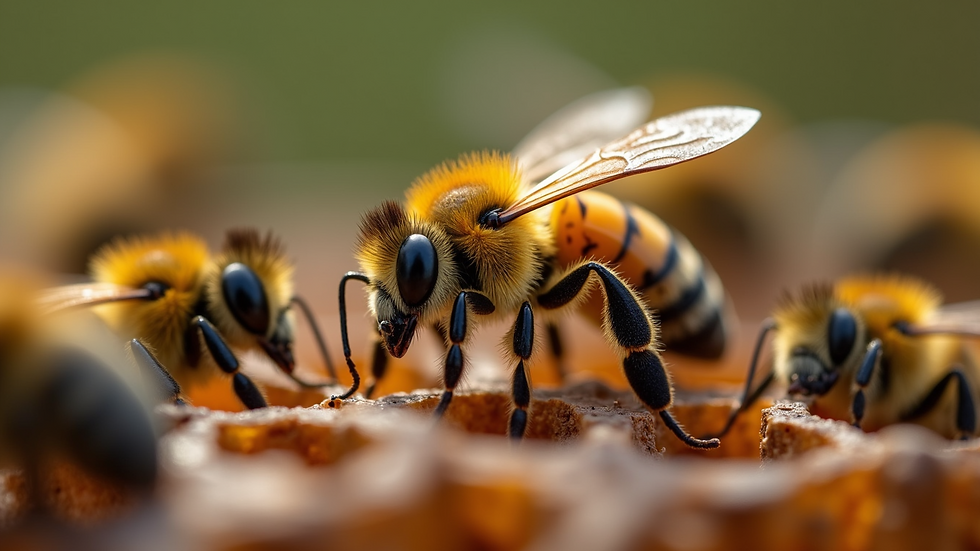Top Tips for Successful Queen Bee Rearing at Sunshine Honeybees
- Jason Sanroma
- Aug 6
- 4 min read
Queen bee rearing is an essential part of beekeeping. It ensures the health and productivity of your hive. At Sunshine Honeybees, we believe that successful queen rearing can be both rewarding and enjoyable. In this post, we will share our top tips to help you rear strong and healthy queen bees.
Understanding the Importance of Queen Bees
Queen bees are the heart of the hive. They are responsible for laying eggs and maintaining the colony's population. A healthy queen can lay up to 2,000 eggs a day. This means that the success of your hive largely depends on the health of your queen.
When rearing queens, it is crucial to understand their life cycle. Queen bees develop from fertilized eggs and go through several stages: egg, larva, pupa, and adult. Each stage requires specific conditions to thrive.
By focusing on the queen's needs, you can ensure a robust hive.
Selecting the Right Breeding Stock
Choosing the right breeding stock is the first step in successful queen rearing. Look for bees that exhibit desirable traits. These traits may include:
High honey production
Gentle temperament
Resistance to diseases
You can source your breeding stock from local beekeepers or reputable suppliers. Always inspect the health of the bees before making a selection.
Creating Ideal Conditions for Queen Rearing
Creating the right environment is vital for queen rearing. Here are some key factors to consider:
Temperature
Queen bees thrive in warm conditions. Aim for a temperature between 80°F and 95°F (27°C to 35°C). If the temperature is too low, the larvae may not develop properly.
Humidity
Humidity levels should be moderate. Too much moisture can lead to mold, while too little can dry out the larvae. A humidity level of around 50% is ideal.
Space
Ensure that your queen rearing area has enough space. Crowded conditions can stress the bees and affect their health.
Choosing the Right Method for Queen Rearing
There are several methods for rearing queen bees. Each method has its advantages and disadvantages. Here are a few popular techniques:
Grafting
Grafting involves transferring young larvae into queen cups. This method requires skill and practice. It allows you to select the best larvae for queen production.
Cell Raising
In this method, you allow worker bees to raise queens from eggs or young larvae. This is a more natural approach and can yield strong queens.
Split Method
The split method involves dividing an existing colony. You create a new colony with a portion of the bees and brood. This method can be effective but requires careful management.
Feeding and Nutrition
Proper nutrition is essential for queen development. Feed your bees a balanced diet that includes:
Pollen
Sugar syrup
Protein supplements
Pollen is crucial for larval development. It provides the necessary proteins and vitamins. Sugar syrup helps maintain energy levels in the hive.
Monitoring Queen Development
Once you have started the queen rearing process, it is important to monitor the development closely. Check the queen cells regularly. Look for signs of healthy larvae and proper cell construction.
If you notice any issues, such as dead larvae or poorly constructed cells, take action immediately. This may involve adjusting the environment or feeding more nutrients.
Introducing New Queens to the Hive
After your queens have matured, it is time to introduce them to the hive. This step is critical. A smooth introduction can prevent fighting and ensure acceptance.
Steps for Introduction
Cage the Queen: Place the new queen in a small cage with a few worker bees. This allows the hive to get used to her scent.
Wait for Acceptance: Leave the queen in the cage for a few days. The worker bees will begin to accept her scent.
Release the Queen: After a few days, release the queen into the hive. Monitor the hive for any signs of aggression.
Troubleshooting Common Issues
Even with the best practices, issues can arise during queen rearing. Here are some common problems and solutions:
Poor Acceptance
If the hive does not accept the new queen, it may be due to a strong existing queen or a lack of pheromones. In this case, try reintroducing the queen after a few days or using a different introduction method.
Weak Queens
If your queens are weak, it may be due to poor nutrition or environmental stress. Ensure that the bees have access to adequate food and a suitable environment.
Disease
Keep an eye out for signs of disease in your bees. Regular inspections can help catch issues early. If you suspect disease, consult a local expert for advice.
Keeping Records
Maintaining detailed records is essential for successful queen rearing. Document the following:
Breeding stock details
Queen development stages
Hive conditions
These records will help you identify patterns and improve your practices over time.
Continuous Learning and Improvement
Queen rearing is a skill that improves with experience. Attend workshops, read books, and connect with other beekeepers. Learning from others can provide valuable insights and tips.
At Sunshine Honeybees, we encourage continuous learning. Share your experiences with fellow beekeepers and learn from their successes and challenges.
Final Thoughts on Queen Bee Rearing
Queen bee rearing is a rewarding journey. With the right knowledge and practices, you can successfully rear strong queens that will benefit your hive.
Remember to focus on selecting the right breeding stock, creating ideal conditions, and monitoring development closely.
By following these tips, you can enhance your beekeeping experience and contribute to the health of your bees. Happy beekeeping!





Comments